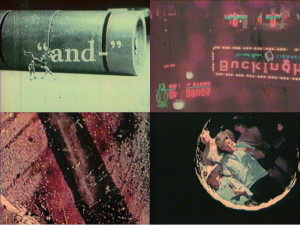
"Perhaps the first experimental film made in British Columbia, this short uses found footage, painted and scratched emulsion, negative and reversed images, chaotic camera movements, and holes punched in the frame and filled with other images. Some portions are hand coloured." (British Columbia Archives.)
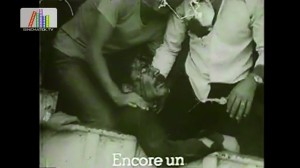
“Bu filmi ile Ümraniye 1 Mayıs mahallesindeki yoksul halkın barınma hakkı mücadelesi 1970’li yılların 2. yarısının atmosferinde veren bir film yapmış […]. 1977 senesinin 2 eylül günü 1 Mayıs Mahallesi’ne gecekondu yıkımı için gelen polisler ile mahalle halkı arasında çıkan ve 12 mahallelinin ölüp onlarcasının yaralandığı çatışmalar sırasında çeşitli sosyalist yapılar etrafında örgütlenmiş mahalle sakinlerinin gösterdiği direniş Türkiye’deki sosyalist mücadele tarihi içerisinde çok önemli bir yere sahiptir [...].” Sinematek.tv: http://sinematek.tv/2-gun-2-eylul-direnisi-1978/ (13 November 2019).
“The conflict between the District May 1 organized in various socialist collectives and the police that came to the district to demolish the shantytown, which resulted in 12 people living in the district killed on 2 September 1977 has an important place in the history of the socialist movement in Turkey [...]. [İshak Işıtan’s] film is about the poor people of Ürmaniye/District May 1’s a struggle for the housing right reflecting the atmosphere of the second half of the 1970s [...]. Sinematek.tv: http://sinematek.tv/2-gun-2-eylul-direnisi-1978/ (13 November 2019).
"Narró en la cinta la reflexión existencial de un personaje que piensa sobre la relación entre los ideales genuinos y la realidad que lo rodea. En ella el tema político ocupaba un marco sutil pero presente. El título sugiere el regreso a un lugar donde el pensamiento comience de nuevo, sin supuestos previos. En la cinta de Belaunzarán aparecen mezclados varios elementos que perturban la reflexión del personaje: la propaganda política, Telesistema Mexicano, las imágenes sobre Vietnam, Biafra, Tlatelolco" (Vázquez Mantecón, 2012).
"The film was about the existential reflection of a character that thinks about the relationship between genuine ideals and the reality surrounding him. In it the political theme was a subtle framework, but it was present. The title suggests coming back to a place where thought begins again, without previous assumptions. In Belaunzarán's film there are several elements that disturb the reflection of the character: political propaganda, the Mexican Telesystem, images of Vietnam, Biafra, Tlatelolco" (Vázquez Mantecón, 2012).
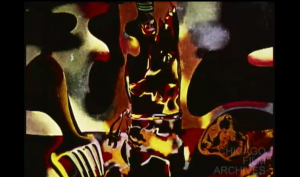
"Abstract Patterns is a two-minute abstract film by Sol Falon of Teaneck, N.J. - a beautiful "shorty" of color and design that is fast moving and stimulating" PSA Journal, Nov. 1969, 56; "A short amateur experimental film featuring mid-century paintings from Pablo Picasso, Wassily Kadinsky, Piet Mondrianand Joan Miro. Disributed by the Society of Amateur Cinematographers (SAC)." Chicago Film Archives
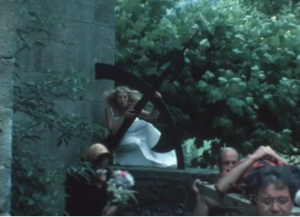
El filme comienza con un hombre vagando por el campo. Encuentra a una mujer vestida de blanco y comienzan a besarse, hasta que eventualmente caen sobre el pasto. El hombre lleva a la mujer vestida de blanco a conocer a una mujer mayor que la rechaza y la hace huir. El hombre va en su búsqueda y nota que ella tiene patas de pato, él cae al suelo y muera mientras ella coloca un pequeño costal café cerca de su pecho. La película muestra después a un grupo de hombres cargando su cuerpo hacia su ceremonia fúnebre mientras la mujer mayor llora detrás de la procesión y la mujer de blanco observa escondida en una esquina. Cuando el cuerpo es dejado solo, la mujer de blanco se aproxima para tomar el costal café y desaparece.
The film begins with a man wandering in the country. He finds a woman dressed in white and they begin to kiss, eventually falling on the grass. The man takes the woman dressed in white to meet an older woman who rejects her and makes her leave. He goes looking for the woman in white and sees that she has duck legs, he falls and dies while she places a small brown sack by his chest. The film then shows men carrying his body to his burial while the older woman cries behind the funeral procession and the woman in white watches hiding in a corner. When the body is left alone, the woman in white approaches him and takes the brown sack back and leaves.
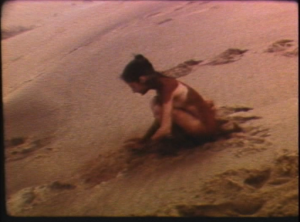
"Arena (Sand, 1986), a soft, grainy projection in which Mexican artist Silvia Gruner, naked, on a beach, climbs a dune, sits, rubs sand and red pigment over her body, and then somersaults all the way down. The video loops, and Gruner repeats her uphill trek again and again. Sisyphean, certainly, and yet her only burden was herself and that looked like freedom" (Brown, 2017)
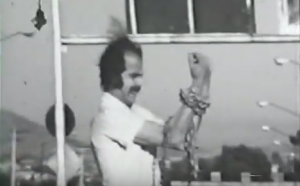
"A successful man living in a great metropolis is increasing awareness of the unjust social reality that lives in the absurdity. This immerses him in a uneasiness that sinks into alcoholism and depression. In his wandering through the streets viewer gets to be the unfortunate suicide of another victim of the meaninglessness of life, which will produce a series of dreamlike hallucinations bordering on the madness. In a stroke of consciousness of his misfortune, he does run aimlessly without course. Devastated, to the dawn, with the light of the dawn he sees to be reborn the hope personified in an innocent girl who stretches the hand donating bread" Internet Archive.
"A five minute abstract film using live action, slow motion and shots showing the interplay of lights on coloured paper. Although the film was silent, its accompanying gramophone record married so well that the film was perceived as a sound film" ("McLaren and Grierson: Intersections").
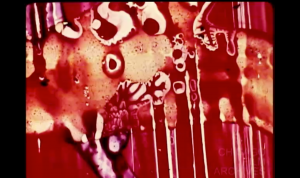
"An amateur experimental film made by Sol Falon and distributed by the Society of Amateur Cinematographers (SAC)." Chicago Film Archives
Total Pages: 4